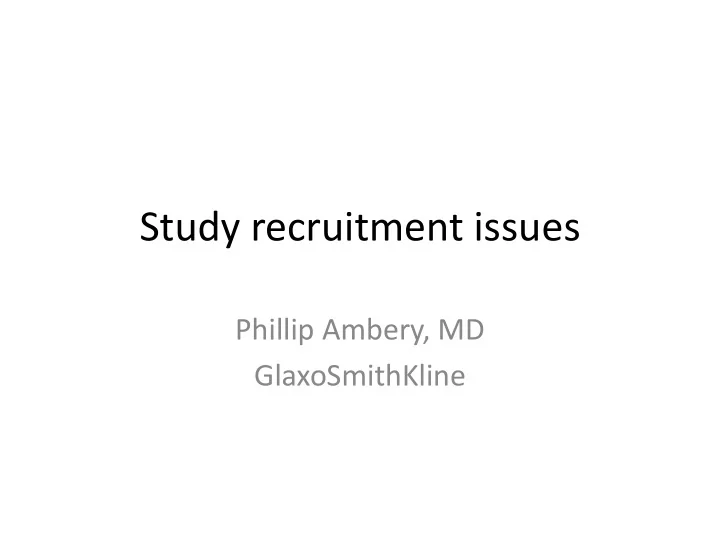

Study recruitment issues Phillip Ambery, MD GlaxoSmithKline
Opposing forces •Providing access •Type 2 diabetes to medicines for is a rare disease children in children •Improving on •Metformin is a glycaemic control / proven medicine tolerability with an extensive afforded by diet safety database and exercise and •Novel medicines metformin may have •Ensuring safety untoward effects and tolerability is in the paediatric adequately population assessed in the paediatric population
Just how rare is type 2 diabetes in children?
Just how many subjects are needed for a paediatric study? • 80% power • 0.5% difference vs placebo in HbA1c for investigational agent • 2:1 randomisation (active vs placebo) • Requires approxiately 120 active, 60 placebo subjects (function of likely effect size and variability of HbA1c)
Summary • Metformin and weight loss are effective in managing paediatric Type 2 diabetes • Despite increasing incidence, it is a rare disease in children • Effect size and variability of HbA1c response necessitate recruitment to relatively large studies
Discussion points • What is appropriate age banding for paediatric studies given the rareity of T2DM in children? • Does the requirement for CV safety data (often post approval) affect the timing of paediatric studies? • What weighting is given towards efficacy endpoints apart from HbA1c (e.g. Weight loss), in paediatric studies?
Enpr-EMA-Pharma Paediatric Type 2 Diabetes Mellitus Meeting Trial Recruitment Issues – a company perspective Pamela Zee, MD Ronald Portman, MD Bristol Myers Squibb/Astrazeneca
Introduction • The key goal of pediatric drug development is to get ‘information’ about a drug to patients and their physicians as quickly as possible • Limited opportunities for pediatric studies: studies need to be well conceived, global, feasible and answer pertinent and practical questions in a timely manner • We are committed to accomplishing these goals but have encountered roadblocks to achieving them • Need to define the roadblocks and innovate strategies to overcome them
Recruitment issues • “Epidemic” of T2DM is relative – Small percentage of total DM patients in US,EU; numbers still small • Enrollment criteria – Monotherapy: Placebo use is a barrier to enrollment (especially in light of AAP guidelines) – Add-on to Metformin: Enrollment only if not controlled on metformin, TODAY study – Concomitant insulin use: large number of patients taking insulin – 30% of patients should be recruited in EU member states or in countries with ethnicities and lifestyle that are analogous to those in EU countries. (not including US) – Only up through age 17 yrs • Other enrollment considerations – Few registries to identify patients • Number of studies being performed industry, academic: over 2000 patients being sought – • Design and size of studies: requiring more patients to be screened – Similar to traditionally designed efficacy trials in adults • New approach needed to provide dosing, efficacy, safety information – Formulation less of an issue in this population
Pediatric T2DM recruitment: saxagliptin experience Extensive recruitment/feasibility work was performed for both studies • 999 sites in 20 countries were contacted (monotherapy) 948 sites in 19 countries were contacted (add-on to metformin) • “lack of patient population” • • EU/EU-like sites: ~ 39%; Non-EU sites: ~52% (monotx • EU/EU-like sites: ~ 43%; Non-EU sites: ~50% (Add-on met) • 83 sites in 11 countries ( mono) • 105 sites in 12 countries (add on to met) • 4 subjects (monotherapy) • 1 subject (add-on to metformin)
Prescreening Data in patients presumed to have T2DM Global Total Any other anti-diabetic treatment within 2 months 18.5% Pt’s age is 10 to 17 years and 32 weeks 3.8% Other 13% Insulin use within 6 months 36.1% HbA1c > 7% and < 10.5% 34.2%
Possible Solutions • Broaden entry criteria to enhance feasibility and reflect current clinical practice – Recent saxa PIP modification, (awaiting FDA feedback) • Multi-company study with multiple agents within the same drug class using one control group • Single company with multiple agents spanning different drug classes • Study in related disease states (T1DM, pre- diabetes) • Extrapolation Model
Recommend
More recommend